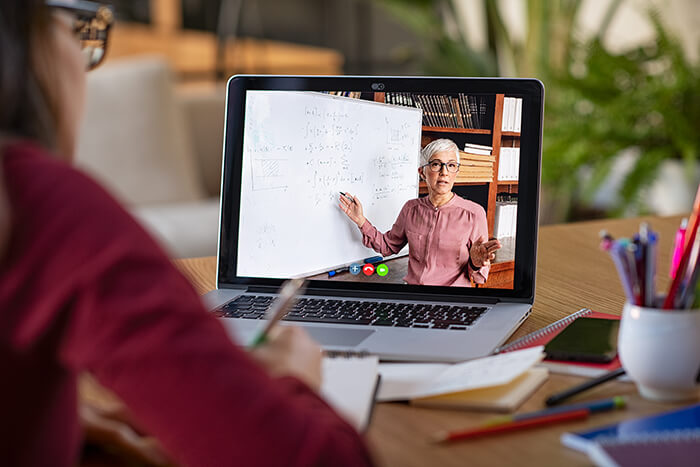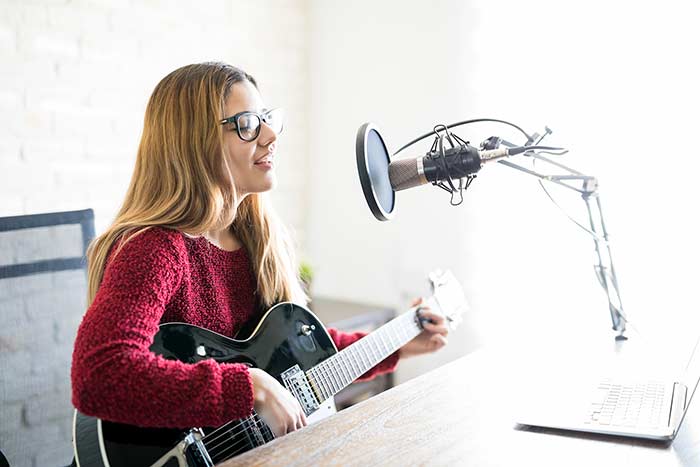Finding the Best Online Music Lesson Setup
An increasing number of music teachers and students are moving into the realm of online music lessons. They are an amazing way to connect educators and pupils from differing geographical locations, to learn from the comfort of your own home, thus saving time and money. But there are, of course, complications when it comes to learning this way. Technical issues, lack of video and audio clarity can all lead to a poor online learning experience. We have put together our online music lesson tips to help you make the most of them!
Consider your environment
We can’t stress this enough, your environment is key to a good online music lesson. Normally, your teacher will have taken care of this, but now that you’re learning from home, you need to make sure that your room is suitable for a lesson. Try to eliminate distractions as much as you can. If you live with other people, it may be worth letting them know when you will be studying so they are aware and can give you some peace and quiet during this time. Make sure you have everything you need for your lesson, such as laptop charger, your instrument, sheet music, some water if you need it. This way, you won’t have to interrupt the lesson to get the things you need, and you can fully focus on what your teacher has to say and make the most of the time you have with them.
Lights, camera, action!
Good lighting and clear footage are crucial for a number of reasons. Firstly, it can be difficult to perceive other people’s expressions if you can’t see them clearly, leading to issues and interruptions in communication. Secondly, your teacher needs to be able to see as much detail as possible to properly assess your playing or singing. Make sure that the room you’re learning in is well lit with natural or artificial lighting. Never sit in front of the light source, but face it instead, however, be careful not to look too overexposed. Your ideal camera angle will depend on the instrument you’re playing. For example, guitar or any other instrument you place on your lap is the easiest to set up for, as the camera just needs to face you sitting upright or be zoomed in for more detail. Similarly, if you’re a vocalist, your teacher mainly needs to see your posture, breathing and facial expressions. It gets tricky for instruments like violin or piano. With a violin, your camera would need to be level with your shoulders, so it won’t suffice to simply place it on a desk in front of you. Piano is probably the trickiest to set up, as, ideally, your teacher would need to look at the instrument from the top, so you may need to invest in a tripod that allows for camera to face down, overlooking the keyboard. In terms of video, most recent devices will provide sufficient quality, however, you could invest in a USB webcam if you feel your gadget isn’t quite up to scratch. We would also recommend using a laptop, as you can tilt the camera at an angle that suits you. A tablet or a phone may work better if you need a tripod to set your camera up in a more specific position.
The technical bits
While using standard video conferencing applications like Skype, Zoom and Google Hangouts work perfectly fine for most work situations where the main form of communication is speech, musicians need a bit more consideration to be able to collaborate, learn and teach effectively. Here are some key areas to look at.
Internet connection
Having a good internet bandwidth will eliminate lagging issues and allow for higher quality audio and video streaming. A very interesting study looked at remote collaboration and observed that musicians can tolerate latency of up to 30ms, while dancers, by comparison, could tolerate latency of up to 250ms. Musicians also rely on visual cues from their collaborators, highlighting just how important it is to have good internet speed and, consequently, reduced latency and high-quality video. It is recommended that your download speed is at least 20-25 megabytes per second (mbps) and your upload speed is at least 2-3 mbps. Many providers offer fast download speed, yet very slow upload speed, so make sure you consider both for the best results.
Video conferencing software
The best online music platform will depend on your preference and requirements. Most video conferencing apps will pretty much do the same thing, but they will vary slightly. For example, Facebook Messenger and Google Hangouts will require you to have a Facebook and Gmail account respectively. Zoom and Skype are both very popular choices. Zoom provides a lot of adjustments to the audio, such as latency alteration and background noise suppression. On the other hand, if you’re planning to use more than one camera angle, which can be useful for piano, you would need to call from two separate accounts and form a group chat. Skype could be the better online music lesson software here, as Zoom group calls are only limited to 40 minutes in the free version. Some of the online music lesson software may work better than others for you, so it’s worth having a back-up in case you’re experiencing technical issues on one of the platforms and need to switch to another.
Microphone
The microphone in your laptop may be sufficient for conference calls, but it won’t provide the clarity and detail of sound that would be desirable for a good online lesson. Of course, a laptop mic is better than nothing, but if you are serious about getting the best possible online music lesson equipment, we would recommend looking into buying a microphone – USB mics are a great and easy option. While dynamic microphones may be better for eliminating background noise, if you’re looking for more detail, go for a condenser mic instead. Alternatively, an XLR microphone is a great choice, however, you will also need an audio interface or a soundcard as opposed to a USB mic, which will just plug straight into your computer. Here it really depends on your budget. An XLR microphone with a soundcard is a great choice to go for if you’re planning to do more recording in the future. While it can be done with a USB mic, the audio interface will make it easier for your computer to process high quality audio, as it offsets the processing power required to do it. The great thing is, investing in music tech equipment will not just improve your online music lessons – it will also introduce you to the basics of home recording and livestreaming, which can really add to your skillset as a musician.
Additional online music lesson equipment
Lastly, your teacher will not be able to accompany you during an online lesson, so it’d be useful to have your own instrument if you’re a vocalist or to prepare some backing tracks in advance. We would recommend playing these through a good speaker, as you may overpower your phone, making the performance ineffective, since your teacher won’t be able to hear it in the context of the backing track. For your convenience, a music stand would be useful, and you can also look into tripods and stands for your laptop or tablet. Of course, these aren’t mandatory, but they could seriously improve your experience and allow you to make the most of your online lessons.
Tags: Online music lessons, Zoom music lessons, Equipment for online music lessons




